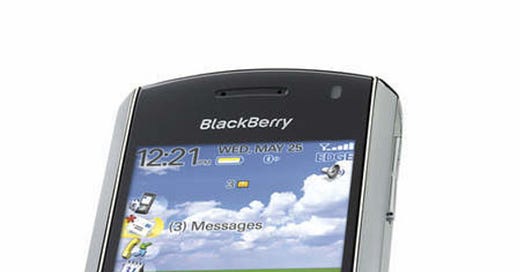Re-running from the archives today. Back tomorrow.
Colin here. Join me for a quick trip back to the recent past. The time is 2006 and BlackBerry, the must-have phone, released the Pearl, its slim replacement to the blue brick of yesteryear. This was two years before the iPhone, and your choices for a smartphone essentially boiled down to a Sidekick (deserving of its own WITI) or a Blackberry (unless you were still rolling with a Palm Treo). Noah and I were obsessed with the device, and I still think I can type on it faster than anything else. The odd layout managed to offer a perfect sense of tactile feedback.
But aside from how great this device was for communicating by text, I also used the hell out of Blackberry Messenger (BBM), the messaging protocol that has since all but disappeared from memory. The first time I learned about it, my friend Adam Freeland asked me for my pin. He showed me how to look it up on my device and within seconds I had an instant link. BBM was international and secure, plus it existed outside the pay-per-SMS model that was still prevalent at the time. BBM was very much a word-of-mouth thing, the ultimate Blackberry insider flex, and a lot of people used it—there were still 43 million active BBM users in 2011. Ultimately the iPhone and competitive messaging apps killed BBM, with the service officially put to rest in 2019.
Why is this interesting?
We don’t really give it the credit it deserves, but BBM was in many ways the gateway drug for a lot of mobile chat apps we use today: Whatsapp, Signal, Telegram, etc. The Verge remembers:
BlackBerry Messenger (better known as BBM) was one of the first instant messaging (IM) platforms that arrived on mobile devices in 2005. People could choose to use a BBM account tied to their unique BlackBerry Pin rather than send a standard text message. BBM managed to take traditional desktop messaging and translate it to the tiny computers in our pockets. It was astounding.
The platform was also responsible for another controversial feature: read receipts!
BBM helped create one of the most anxiety-inducing messaging features that still exists today: read receipts. Read receipts were introduced alongside BBM in 2005. When a message was sent, a tiny letter “D” would appear beside it. When that same message was read, the “D” would change to an “R.” People thought it was genius. Colleagues knew when someone was available and could hear back instantaneously.
Just as one can have a little archeological dig by signing into an old AIM screenname, there’s a way to look at old chat histories from old BlackBerry devices. Who knows what 2007 missives you will find! (CJN)
WITI Classifieds:
We are experimenting with running some weekly classifieds in WITI. If you’re interested in running an ad, you can purchase one through this form. If you buy this week, we’ll throw an extra week in for free on any ad. If you have any questions, don’t hesitate to drop a line.
Stat Significant is a weekly newsletter featuring data-centric essays about culture, economics, sports, statistics, and more. Check out Stat Significant.
Supercharge your lifelong learning. Upnext lets you save any content, and actually get to it later. Supports articles, podcasts and video! Try Upnext for free
For the inner journey. For the outer journey. The Intermodal Spirit. Subscribe here.
For 10 years, this has been the go-to newsletter for people who like to keep up with what’s exciting in design, books, beauty, food, & more. Subscribe
BrXndscape is a landscape of Generative AI companies specifically designed for the needs of marketers. Explore AI for marketers.
January is a great month to begin working with a coach to meet your goals. Gain insight, accountability, and support. Subscribe to Mission





